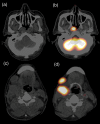A prospective clinical trial of tumor hypoxia imaging with 18F-fluoromisonidazole positron emission tomography and computed tomography (F-MISO PET/CT) before and during radiation therapy
- PMID: 23589026
- PMCID: PMC3823770
- DOI: 10.1093/jrr/rrt033
A prospective clinical trial of tumor hypoxia imaging with 18F-fluoromisonidazole positron emission tomography and computed tomography (F-MISO PET/CT) before and during radiation therapy
Abstract
To visualize intratumoral hypoxic areas and their reoxygenation before and during fractionated radiation therapy (RT), (18)F-fluoromisonidazole positron emission tomography and computed tomography (F-MISO PET/CT) were performed. A total of 10 patients, consisting of four with head and neck cancers, four with gastrointestinal cancers, one with lung cancer, and one with uterine cancer, were included. F-MISO PET/CT was performed twice, before RT and during fractionated RT of approximately 20 Gy/10 fractions, for eight of the 10 patients. F-MISO maximum standardized uptake values (SUVmax) of normal muscles and tumors were measured. The tumor-to-muscle (T/M) ratios of F-MISO SUVmax were also calculated. Mean SUVmax ± standard deviation (SD) of normal muscles was 1.25 ± 0.17, and SUVmax above the mean + 2 SD (≥1.60 SUV) was regarded as a hypoxic area. Nine of the 10 tumors had an F-MISO SUVmax of ≥1.60. All eight tumors examined twice showed a decrease in the SUVmax, T/M ratio, or percentage of hypoxic volume (F-MISO ≥1.60) at approximately 20 Gy, indicating reoxygenation. In conclusion, accumulation of F-MISO of ≥1.60 SUV was regarded as an intratumoral hypoxic area in our F-MISO PET/CT system. Most human tumors (90%) in this small series had hypoxic areas before RT, although hypoxic volume was minimal (0.0-0.3%) for four of the 10 tumors. In addition, reoxygenation was observed in most tumors at two weeks of fractionated RT.
Keywords: 18F-misonidazole; PET/CT; reoxygenation; tumor hypoxia.
Figures



References
-
- Vaupel P, Mayer A. Hypoxia in cancer: significance and impact on clinical outcome. Cancer Metastasis Rev. 2007;26:225–39. - PubMed
-
- Asquith JC, Watts ME, Patel K, et al. Electron affinic sensitization. V. Radiosensitization of hypoxic bacteria and mammalian cells in vitro by some nitroimidazoles and nitropyrazoles. Radiat Res. 1974;60:108–18. - PubMed
-
- Chapman JD, Baer K, Lee J. Characteristics of the metabolism-induced binding of misonidazole to hypoxic mammalian cells. Cancer Res. 1983;43:1523–8. - PubMed
-
- Koh WJ, Rasey JS, Evans ML, et al. Imaging of hypoxia in human tumors with [F-18]fluoromisonidazole. Int J Radiat Oncol Biol Phys. 1991;22:199–212. - PubMed
-
- Zimny M, Gagel B, DiMartino E, et al. FDG—a marker of tumour hypoxia? A comparison with [18F]fluoromisonidazole and pO2-polarography in metastatic head and neck cancer. Eur J Nucl Med Mol Imaging. 2006;33:1426–31. - PubMed
Publication types
MeSH terms
Substances
LinkOut - more resources
Full Text Sources
Other Literature Sources
Medical

